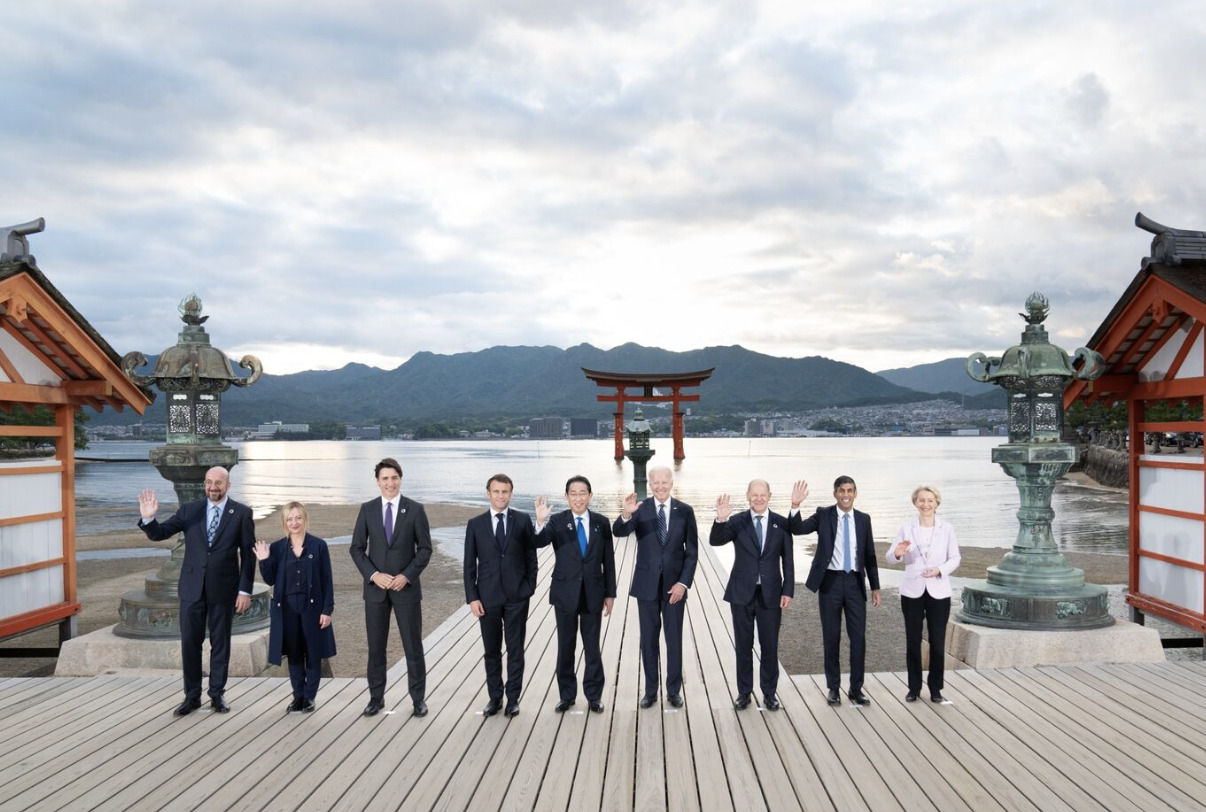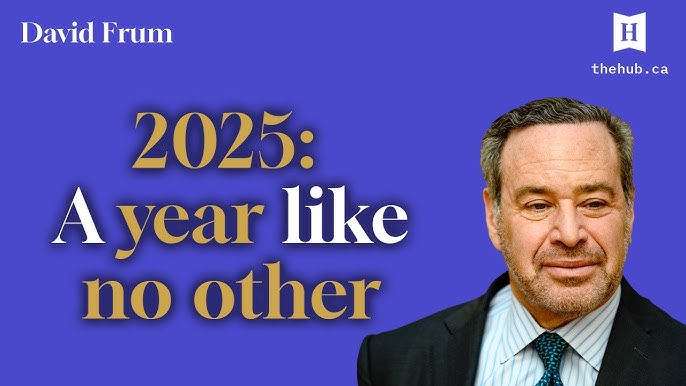
Peter Goodman: The Messy Reality of ‘Made in America’
The construction of a giant factory complex in Arizona was supposed to embody the Trump administration’s ability to bring manufacturing back to the United States.…
Thought Leader: Peter Goodman

On recent visits to Lisbon and Paris, I heard much discussion of American leadership. I was reminded of what Mahatma Gandhi supposedly said when he was asked for his view of Western civilization — that it would be a very good idea. I feel the same way about American leadership: It would be a very good idea.
It’s a view that seems to be quite widely shared within the European elite, though few of the continent’s leaders dare to say so out loud.
An essential ingredient of leadership is an inspiring destination. Where exactly is it that the US would like its allies to follow? A good answer to that question can be found in the National Intelligence Council’s Global Trends 2040 report, which envisions five scenarios for 17 years hence.
The desired one is obviously “Renaissance of Democracies,” in which the US leads a resurgence of what used to be called the free world. But it is worth reviewing the other four destinations — the ones to be avoided:
The striking thing to me is that, just two years after the document was published, we are already in Scenario 3:
The US-China rivalry and other state-to-state relations are channeled into competition for markets, resources, and brand reputation … Strengthened economic interdependence lowers the risk of the major powers pursuing armed conflict; most of them engage in influence operations, corporate espionage, and cyberattacks that allow them to achieve goals without risking destructive wars.
The central security challenge is how to keep the geopolitical competition between the United States and China from undermining the economic cooperation upon which their prosperity and the global economy depends.
Long-term stability remains at risk from growing climate challenges that were ignored in favor of near-term economic gains; technological innovations and economic prosperity have lulled leaders into believing that they can put off making hard choices on climate change.
Many Europeans have the unpleasant feeling of being caught between two superpowers in a new cold war. They know China is partly to blame for this. But they see the US as equally culpable.
Superficially, of course, the US-led transatlantic alliance is doing much better than might have been expected in its response to the Russian invasion of Ukraine last year. The problem is what might be called “the power law — geopolitical edition,” meaning that the contributions of the 38 countries supporting Ukraine’s war effort are not normally distributed but follow a power law. Put crudely, there is one very large contributor and a lot of very small ones. The very large contributor is of course the US.
According to the most recent data on bilateral commitments from the Ukraine Support Tracker, US commitments of all kinds to Ukraine (financial, humanitarian and military) are seven times greater than those of the next-largest nation state, the UK. They are 15% above the total commitments of all EU members and institutions combined. And US commitments are 45% greater than those of all the other 39 nation states combined. In other words, the US really does lead not only NATO, but also the larger, informal coalition of pro-Ukrainian states.
Top 15 commitments of aid to Ukraine
Source: Ukraine Support Tracker
Note: Excludes 24 governments that have committed less than €900 million each in combined financial, military and humanitarian aid.
The reason this is a problem — as opposed to an inherent feature of US leadership — is that it makes any American-led effort abroad heavily reliant on the support of US voters. And they are fickle, especially when they feel that Uncle Sam is being taken in by a bunch of free riders. Nearly 60 years after the publication of Henry Kissinger’s The Troubled Partnership, the trouble remains that the American partners pay a disproportionate share of the cost of defending of Europe.
Right now, 15 months into the war in Ukraine, the American public is still on board. According to a recent Harvard Harris poll, only 23% think President Joe Biden’s administration has done “too much” to counter Russia in Ukraine. Only 15% of Americans think the Biden administration has been “too strong” in its China policy. But history tells us that such shares can grow rapidly, especially if economic times get tougher and as a presidential election draws near.
This brings us to the question of US economic leadership. So long as the American economy is doing better than those of its allies and rivals, Washington can afford to lead in the way we currently see in Ukraine. Superficially, once again, things look good. The Economist, for example, believes the US is “riding high” and “peak China” is approaching.
But on closer inspection the picture is less rosy. For one thing, as the political class reminded us with their recent game of chicken over the debt ceiling, American public finances are on an unsustainable path. The federal deficit is projected to be above 5% of GDP for the next 10 years, hitting 7.3% in 2033. And the trajectory will probably be even worse than the Congressional Budget Office projects, as it has consistently underestimated the growth of the debt to GDP ratio throughout the past 20 years. Debt service is expected to exceed defense spending in 2029. I suspect it will be sooner than that. The history of previous empires that spent more on interest payments than on national security is not encouraging.
Americans are also still paying the higher prices of a grave monetary policy error by the Federal Reserve, which slept through the revival of inflation during 2021 and the early months of 2022. Inflation is now coming down, to be sure, but not to the Federal Reserve’s goal of 2%. The fact that a headline annual rate of 4% and a core rate of 5.3% were thought good enough to justify a pause — rebranded as a “skip” — in the hiking cycle last week speaks for itself. The Fed’s credibility of the 2% average inflation target is in tatters.
No economist can fully explain why 525 basis points of monetary tightening since the beginning of last year have not had a bigger impact. The strength of the labor market and the resilience of the consumer are astonishing. There were 10.1 million job openings in April, up from 9.7 million in March, far exceeding the 5.7 million unemployed Americans that month. Average hourly earnings grew by 4.3% in May compared with year earlier.
A part of the explanation is the Biden administration’s ongoing stimulus of the economy, now also rebranded as “industrial strategy.” In the words of the financier and commentator Steve Rattner, “America is undergoing a factory construction boom,” with real construction spending in manufacturing hitting $190 billion in May. This is part of what you get from around $1.2 trillion in infrastructure-related subsidies, about the same amount in green subsidies, and $39 billion in subsidies for semiconductor production.
With inflation falling and the economy nevertheless booming thanks to the kind of big-government policies Democrats last believed in when Biden was a freshman senator, you might expect the public to be ecstatic. But no good deed goes unpunished in this thankless vale of tears: Gallup’s Economic Confidence index is currently at its lowest level since February 2009. True, with a 42% approval rating, Joe Biden is doing better than Jimmy Carter at the same stage of his one and only presidential term (in May 1979, Carter was at 28%, according to Gallup). But Biden is faring worse than Gerald Ford and George H.W. Bush, two other presidents who failed to secure reelection.
Does the US have a leadership strategy? In a column last month, I discussed National Security Adviser Jake Sullivan’s speech at the Brookings Institution, where he set out the administration’s five-step “foreign policy for the middle class.” A key part of that speech explained why the new US industrial strategy poses no threat to American allies, because they are being encouraged to follow the American example. He also implied that the same was true of confining America’s technological lead over China in “a small yard [with a] high fence.”
Officially, the US and the European Union are on the same page when it comes to “de-risking” their economic relationship with China. But privately, Europeans have their doubts. First, they see the Inflation Reduction Act as “America First — Biden edition.” Second, they know that Sullivan’s high fence keeps them out of the artificial intelligence race (except maybe as regulators). Third, they worry about the unintended consequences of what amounts to a US policy of technological containment of China.
No one I spoke to in Europe expected much to come of Washington’s current efforts to “thaw” the new cold war with China (as Biden put it at the G7 meeting in Hiroshima, Japan, last month). Sure, Sullivan recently met Wang Yi, China’s top foreign policy official, in Vienna. Sure, CIA boss William Burns made a secret trip to Beijing to meet with his counterparts in Chinese intelligence. And sure, Secretary of State Antony Blinken has meetings in Beijing this weekend — though at the time of writing it’s still not clear with whom.
But Chinese Defense Minister Li Shangfu pointedly refused to hold talks with his US opposite number, Lloyd Austin, at the Shangri-La Dialogue in Singapore two weeks ago. In his speech at the event, Austin warned that a conflict over Taiwan would be “devastating … affect[ing] the global economy in ways that we cannot imagine” and reiterated calls for greater communication between the two superpowers’ militaries.
But Li — who is still under US sanctions imposed in 2018 — was not interested. His Shangri-La speech was shockingly combative in its criticism of the US (“some country”) for having “willfully interfered in other countries’ internal affairs and matters … and frequently resorted to unilateral sanctions.” Money quote: “When friends visit us, we welcome them with fine wine. When jackals or wolves come, we will face them with shotguns.” Some thaw.
The only logical conclusion is for US businesses to get out of China — not just to de-risk but to decouple. There is no other way to interpret the venture-capital giant Sequoia’s announcement last week that it is splitting itself into three separate entities: Sequoia in the US, HongShan in China, and Peak XV Partners in India. When rival VC firm Andreessen Horowitz declares that it will prioritize investing in “American dynamism” and acting in the “national interest,” you see where things are going.
The problem for America’s European and Asian allies is that de-coupling from China is very hard to do. Just think, as I pointed out two weeks ago, of the huge investments European car makers have made in Chinese electric vehicle factories.
A good question to ask about American leadership is: Who’s not following? A map of the 38-country pro-Ukraine coalition of the more-or-less-willing looks familiar: It’s essentially North America, Western Europe, Japan and the Antipodes. In the language of geopolitics developed in the last century by Halford J. Mackinder and Nicholas J. Spykman, this is the “Rimland” — as opposed to the vast Eurasian “Heartland” that stretches from the blood-soaked and waterlogged battlefields of the Dnipro to the now dull and despondent streets of Hong Kong; from the prison colonies east of Moscow to the labor camps of Xinjiang, by way of the gallows of Tehran. (My Bloomberg Opinion colleague Hal Brands presciently saw the new relevance of Mackinder two years ago.)
The 2002 “axis of evil” — Iran, Iraq and North Korea — was a speech-writer’s fiction. The 2023 “axis of ill will” — China, Russia, Iran — is a reality. Jimmy Carter’s national security adviser, Zbigniew Brzezinski, wasn’t Kissinger, but he was still pretty good. In The Grand Chessboard (1997), he warned us:
Potentially, the most dangerous scenario would be a grand coalition of China, Russia, and perhaps Iran, an “antihegemonic” coalition united not by ideology but by complementary grievances. It would be reminiscent in scale and scope of the challenge once posed by the Sino-Soviet bloc, though this time China would likely be the leader and Russia the follower. Averting this contingency, however remote it may be, will require a display of US geostrategic skill on the western, eastern, and southern perimeters of Eurasia simultaneously.
To many states around the world, that skill seems conspicuous by its absence. More and more of them are therefore reluctant to follow the American leader. Jared Cohen — formerly at Google, now at Goldman Sachs — has just published a brilliant essay on “The Rise of Geopolitical Swing State” (my version, presented at the Milken Institute conference last month, was the “polyamorous cold war”), which identifies four distinct categories:
In the Cold War, countries such as India and Yugoslavia proclaimed themselves non-aligned, owing loyalty to neither the US nor the USSR. Today’s swing states, Cohen argues, “will often choose multi-alignment, a strategy that will make them critical — and sometimes unpredictable — forces.”
I tried these ideas out in Paris in conversations that included two of President Emmanuel Macron’s advisers. Supposing there was a war between the US and China over Taiwan, I asked, on whom could Washington rely? “Japan, the UK, Australia. Maybe Canada. That’s it,” was one of the replies.
I was even more startled by the pessimism about Ukraine. “If Trump wins in November next year,” I ventured, “then Zelenskiy is screwed.” “He is screwed whatever happens,” another of my interlocutors replied. “Ukraine cannot get back the Black Sea coast that it has lost” — the so-called land bridge to Crimea. “So the war is effectively over and Putin has won.”
Such conversations reveal a Europe torn between the familiar security of the transatlantic alliance and economic self-interest that barely overlaps with that of the US. And if you think Paris is wobbly, I invite you to visit Berlin. There you will quickly see that Germany — now in recession and with the far-right Alternative für Deutschland polling at a record 20% in the latest YouGov survey — is losing its nerve not only about the war in Ukraine but also about the green-energy transition.
Other recent polls are revealing. An ECFR survey on foreign policy asked European voters how their country should respond to a potential US-China war over Taiwan. Some 60% of Germans favored neutrality; just 23% would want Germany to support the US. And if China started openly delivering ammunition and weapons to Russia? Only 37% of Germans would support imposing sanctions on China.
Europeans’ views on how to respond to a potential conflict between the US and Mainland China over Taiwan
Source: European Council on Foreign Relations
Note: Online survey conducted from April 4–20 in 11 EU countries with total of 16,168 respondents from nationally representative samples.
As for climate change, it’s a clear case of the St. Augustine principle: “Give me chastity and continence — but not yet.” Around three quarters of Europeans want their governments to plant more trees or to pay them subsidies to make their homes more energy efficient, according to a new YouGov poll of seven EU countries. But only around 20% of Germans are themselves willing to switch to an electric car or would support a ban on sale of petrol or diesel cars.
US leadership would indeed be a good idea. A trip to Europe undermines your faith in it. It is partly, of course, the diminishing credibility of Reagan’s “shining city on a hill” as a role model — understandable when a former president may have to win reelection next year to avoid going to jail.
But there is something more profound at work. The US today is the undisputed leader of Spykman’s Rimland against the Heartland, much as it was in the 1950s. But the Rim is somehow thinner than it was back then. And today it shows the first worrisome signs of cracking.
Peter Goodman: The Messy Reality of ‘Made in America’
The construction of a giant factory complex in Arizona was supposed to embody the Trump administration’s ability to bring manufacturing back to the United States.…
Thought Leader: Peter Goodman
Peter Zeihan: The Death of the US Tech Sector
We’re doing a two-part series on the tech sector. Today, we’ll be looking at the disruption caused by deglobalization and Trump’s policies. The gadgets and…
Thought Leader: Peter Zeihan
David Frum breaks down 2025’s defining moments
Leading author, journalist, and thinker David Frum and The Hub’s editor-at-large Sean Speer reflect on the most significant political developments of 2025. They discuss a…
Thought Leader: David Frum

